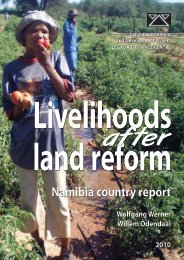“You'll Be Fired if You Refuse†- Human Rights Watch
“You'll Be Fired if You Refuse†- Human Rights Watch
“You'll Be Fired if You Refuse†- Human Rights Watch
You also want an ePaper? Increase the reach of your titles
YUMPU automatically turns print PDFs into web optimized ePapers that Google loves.
History of Zambia’s Copper Industry<br />
Copper mining began in the British colony of Northern Rhodesia, now Zambia, in 1928 and<br />
immediately dominated the country’s economy. 14 The stretch along the Zambian and<br />
Congolese border became known as the Copperbelt for the enormous deposits located<br />
there. More than 80 years later, the Copperbelt remains the “backbone of the Zambian<br />
economy,” contributing to nearly 75 percent of the country’s exports and two-thirds of the<br />
central government revenue during years of strong copper prices. 15<br />
At Zambia’s independence in 1964, copper mining was controlled by two private<br />
companies: the UK (and later Roan) Selection Trust and the British-South African owned<br />
Anglo American Corporation. With high copper prices in the 1960s and early 1970s, Zambia<br />
grew to a middle-income country, with one of Africa’s highest Gross Domestic Products. 16<br />
Zambia’s first president, Kenneth Kaunda, was quickly concerned with the little money that<br />
the companies invested in the country’s long-term growth, however. The government<br />
sought higher taxes and the companies demurred; in 1969, following a constitutional<br />
referendum, Kaunda responded by nationalizing the industry. 17 The two copper mining<br />
companies were reorganized and became Nchanga Consolidated Copper Mines Limited<br />
(NCCM) and Roan Consolidated Mines Limited (RCM). 18 In 1982, NCCM and RCM merged to<br />
form Zambia Consolidated Copper Mines (ZCCM).<br />
Prior even to nationalization, the copper mining companies were expected to provide housing,<br />
foodstuffs, and health care for employees. After nationalization, the amenities grew further as<br />
companies “operated ‘a cradle to grave’ welfare policy” in which they offered free education<br />
for miners’ children and subsidized housing, food, electricity, water, transport, and family<br />
burial arrangements. 19 Services were provided to entire mining communities, with companies<br />
maintaining roads, street lights, and trash collection and offering social and sporting clubs as<br />
well as skills training for women and youth. The mining units also maintained town hospitals,<br />
often where no government hospital existed. The mining divisions, and ZCCM as a whole,<br />
essentially replaced the government in providing social services. The powerful union, the<br />
Mineworkers Union of Zambia (MUZ), was influential in obtaining many of these benefits. 20<br />
14 Alastair Frasier and John Lungu, For Whom the Windfalls?: Winners & losers in the privatisation of Zambia’s Copper Mines, 2007, p. 7.<br />
15 Charles Bweendo Muchimba, The Zambian Mining Industry: A Status Report Ten Years After Privatization, 2010, pp. 3, 5;<br />
Frasier and Lungu, For Whom the Windfalls, p. 7.<br />
16 Frasier and Lungu, For Whom the Windfalls, p. 7.<br />
17 Ibid (“All rights of ownership of minerals as well as exclusive prospecting and mining licenses reverted to the state… [and] [t]he mining<br />
companies were forced to give 51% of shares in all existing mines to the State.”). See also Muchimba, The Zambian Mining Industry, p. 5.<br />
18 They both operated under the parastatal Zambia Industrial and Mining Corporation (ZIMCO).<br />
19 Frasier and Lungu, For Whom the Windfalls, pp. 7-8.<br />
20 For discussion of social services, see Ibid., pp. 7-8; Muchimba, The Zambian Mining Industry, pp. 14-16.<br />
17 HUMAN RIGHTS WATCH | NOVEMBER 2011
















